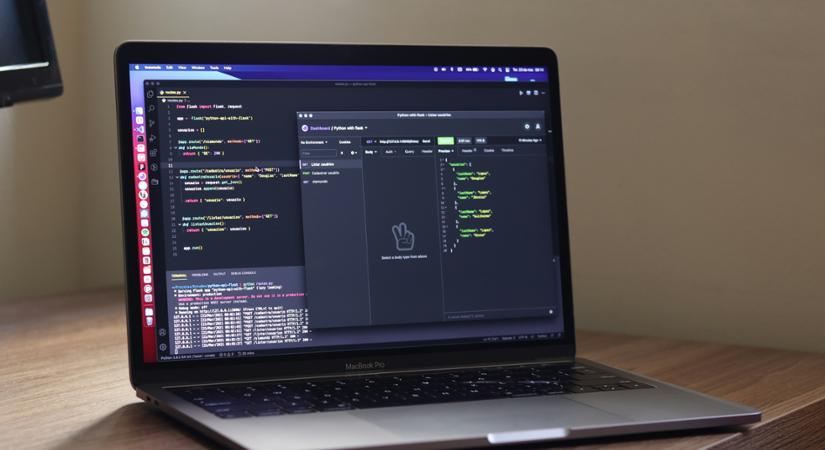How to Build a Pet Care App: Full Features & Costs

Ever wondered how to build a pet care app that stands out? With pet owners on the rise, creating a reliable app can make a real difference.
This guide dives into the essential features, costs, and steps involved in building a top-notch pet care app. You’ll find everything you need to know to start your project right here.
You'll discover:
Key features for a standout pet care app: What your app needs to succeed.
Detailed cost breakdown: Understanding the financial investment required.
Development process: Step-by-step guide to building your app.
Tips for success: Expert advice to ensure your app’s success.
P.S., did you know API League offers a wide range of APIs perfect for integrating jokes, trivia, and more into your app? It’s a fantastic way to add extra value and keep your users engaged.
Planning Your Pet Care App

Before you start coding your pet care app, it's critical to lay a solid foundation through meticulous planning and research. This initial stage is pivotal for defining the app’s purpose, understanding the pet care industry, assessing your competitors, and deciding on its key features.
In this section, we'll explore essential steps like market research, competitive analysis, and user demographics to help you build a strong foundation for your app.
Market Research
To carve a niche in the competitive pet care app market, begin with robust market research. The pet industry is rapidly evolving, with increasing demand for innovative solutions.
Understanding current trends, analyzing top competitors, and identifying unique value propositions for your app are essential steps. Here are some key actions to consider:
Understand Current Trends: Use tools like Google Trends to stay updated on what’s popular in the pet care industry. Keeping an eye on trends helps you anticipate user needs and preferences.
Analyze Top Competitors: Study leading apps such as Wag! and Rover. Look at what these apps do well and where they fall short. This analysis will help you find opportunities to differentiate your app.
Identify Unique Value Propositions: Determine what unique features or services your app can offer to stand out. This could be anything from advanced GPS tracking to personalized pet health monitoring.
Tools for Market Research:
Google Trends: Track the popularity of search terms related to pet care apps.
Market Research Databases: Access comprehensive industry reports and statistics.
Competitor Analysis Software: Use tools like SEMrush or SimilarWeb to analyze competitors' strengths and weaknesses.
Competitive Analysis
Take a close look at leading pet apps. These apps have set high standards in the pet care industry by offering seamless pet care services that connect pet owners with dog walkers, pet sitters, and other pet care providers.
To effectively differentiate your app, you need to understand what these apps excel at and where they fall short. Here’s how:
Analyze strengths: Try and understand what makes these apps successful. Is it their user-friendly interface, extensive service network, or reliable customer support?
Identify weaknesses: Pinpoint areas where these apps could improve. Are there reviews and complaints about response times, lack of personalized services, or limited geographic availability?
Opportunities for differentiation and innovation:
Personalized Pet Health Monitoring: If existing pet apps lack this feature, seize the opportunity to offer personalized health tracking for pets. A pet health app could include diet recommendations, exercise tracking, and health reminders tailored to each pet.
Enhanced Social Features: Create a community space where pet owners can share tips, experiences, and organize local meet-ups. This will also provide pet owners with a platform to discuss and review pet products, creating the sense of a supportive community.
Integration with Local Services: Partner with local pet-related businesses to offer exclusive deals and services through your app. This could include grooming, training, veterinary services, and even special offers on pet products.
Pet Walking Services: Offer a platform that connects pet owners with reliable pet walkers, ensuring peace of mind for owners who are away.
Pet Sitting Services: Provide a reliable pet sitting service for pet owners who travel frequently, ensuring their pets are well taken care of in their absence.
Comprehensive Pet Care Services: Include additional services like grooming, nail clipping, and health observations. This all-in-one approach can make your app a go-to solution for pet owners, helping them manage all their pet care needs in one place and providing pet owners with a convenient and comprehensive service.
User Demographics
Identifying and understanding your target audience is crucial. By analyzing key demographics, you can tailor your app's features to meet the specific needs and preferences of your users.
How to understand your target audience:
Age: Different age groups have varying preferences. Younger pet owners might lean towards social networking features, while older pet owners may prioritize health tracking and emergency contact features.
Location: Understand where your users are located. Urban pet owners might need more pet sitting or dog walking services than those in rural areas.
Pet Types: Different types of pets require different care. Ensure your pet app accommodates not just dog and cat owners, but also those with birds, reptiles, and other exotic pets.
Typical Concerns: Identify common concerns and needs for a pet owner. This could include health monitoring, grooming services, finding reliable pet sitters, or other pet care services.
By gaining a comprehensive understanding of user demographics, you ensure your app resonates with a broad spectrum of users in the pet care industry. This targeted approach will help you connect better with pet owners and provide services that genuinely meet their needs.
User Persona Development
Creating detailed user personas is crucial because it lays the foundation for all other aspects of app development. Understanding the target audience in depth allows you to:
Tailor Features and Functionality: Knowing your users’ needs, preferences, and pain points helps in designing features that provide real value. This ensures that the app resonates with its users, leading to higher satisfaction and retention rates.
Improve Marketing and Engagement: Effective marketing strategies depend on understanding who your users are, what they care about, and where they spend their time. User personas help in crafting targeted marketing messages and choosing the right channels for promotion.
Enhance User Experience (UX): A clear understanding of user behavior and expectations allows for creating an intuitive and engaging user interface. This reduces friction, making it easier for users to navigate and use the app, which is essential for retention.
Prioritize Development Efforts: By understanding what matters most to your users, you can prioritize features that will have the biggest impact. This helps in efficient allocation of resources and ensures that the development efforts are aligned with user needs.
Drive Continuous Improvement: User personas are not static; they evolve as you gather more data and feedback. Regularly updating and refining personas helps in keeping the app relevant and continuously improving it based on actual user behavior and preferences.
By focusing on developing accurate and detailed user personas, you set a strong foundation for all subsequent stages of app development, ensuring that the app is user-centered and more likely to succeed in the market.
Feature Planning
Based on the insights gained from your market research and understanding of user needs, plan both core and advanced features for your app:
Core Features: Essential functionalities like pet profiles, appointment scheduling, and vaccination reminders are fundamental for user convenience and app utility. For example, allowing pet owners to store and access their pet’s medical history easily can be a huge time-saver and stress-reducer.
Advanced Features: Consider incorporating GPS tracking, health monitoring, or a social network for pet owners to foster greater engagement and user satisfaction. For instance, integrating a GPS tracking feature can provide real-time updates on a pet's location, offering peace of mind to pet owners.
Pro Tip: Use API League’s robust APIs to integrate these features seamlessly. With a diverse range of APIs, from jokes to trivia, you can add extra layers of engagement and functionality to your app, making it more attractive to users.
Designing an Intuitive User Interface
Creating a well-designed user interface (UI) is crucial in the pet care app development process. An effective UI should balance visual appeal with functionality, ensuring users can navigate the app effortlessly. Here are some tips to achieve this:
1. Prioritize User Experience:
User-Centric Design: Focus on the needs and behaviors of your target users. For instance, pet owners might prefer quick access to features like appointment scheduling, pet health tracking, and emergency contacts. Use personas to understand their expectations and tailor the UI accordingly.
Simplified Navigation: Keep the navigation simple and intuitive. Use familiar icons and labels, and ensure important features are easily accessible within a few taps. For example, a bottom navigation bar with clear icons for Home, Health, Appointments, and Profile can enhance user experience.
2. Visual Consistency:
Consistent Design Elements: Maintain consistency in colors, fonts, and button styles throughout the app. This consistency helps users feel comfortable and confident as they navigate different sections.
Brand Identity: Integrate your brand's identity into the UI design. Use your brand colors and logo consistently to create a cohesive look that users will recognize and trust.
3. Responsive Design:
Cross-Device Compatibility: Ensure the app is responsive and works seamlessly across different devices and screen sizes. This is particularly important as pet owners might use both smartphones and tablets.
Performance Optimization: Optimize the app for speed and performance. Slow-loading screens or laggy interactions can frustrate users and lead to high abandonment rates.
4. Accessibility:
Inclusive Design: Make your app accessible to all users, including those with disabilities. Use alt text for images, ensure sufficient color contrast, and provide options for text resizing. Tools like Google's Accessibility Scanner can help identify and fix accessibility issues.
Voice Commands: Consider integrating voice command features to enhance accessibility. For instance, users could use voice commands to schedule vet appointments or set reminders for medication.
5. Usability Testing:
Conduct Regular Testing: Regularly test your app with real users to gather feedback and identify areas for improvement. Tools like UsabilityHub or UserTesting can facilitate this process.
Iterate Based on Feedback: Use the feedback to make iterative improvements. This continuous loop of testing and refining will help create a more user-friendly app.
6. Pro Tips:
Microinteractions: Use microinteractions to guide users and provide feedback. For example, a small animation when a user successfully books an appointment can enhance the user experience.
Personalization: Incorporate personalized elements, such as greeting users by their pets' names or suggesting relevant content based on their pets' profiles.
7. Tools and Resources:
Design Tools: Use tools like Figma or Sketch for designing your UI. These tools offer collaborative features that can streamline the design process.
Prototyping Tools: Tools like InVision or Adobe XD can help create interactive prototypes for usability testing.
By focusing on these elements, you can design a pet care app interface that is not only visually appealing but also intuitive and user-friendly. Investing in a well-designed UI is not just about aesthetics; it’s a strategic move to ensure user satisfaction and retention.
User Interface (UI) Design
Use tools like Sketch, Figma, or Adobe XD to create detailed wireframes and prototypes that map out the visual and structural layout of your app.
Wireframing: This step is vital for visualizing the app’s functionality and flow, ensuring all elements are logically placed and user-friendly.
Prototyping: Develop interactive prototypes to refine navigation and overall user experience, allowing for adjustments based on testing and feedback.
User Experience (UX) Design
The overall user experience encompasses every interaction your audience has with your app. Enhance UX by conducting user testing sessions to identify pain points and gather actionable feedback for improvements.
For example, testing with a group of pet owners can reveal if the navigation is intuitive and if the app meets their needs efficiently.
Developing Your Pet Care App

This phase is where your plans take shape in the form of actual software.
Technology Stack
Choosing the right technology stack is crucial for your app's functionality and scalability. Here’s a recommended stack:
Backend Development: Use Node.js for its event-driven architecture, which is perfect for real-time applications.
Frontend Development: Opt for React Native to develop a cross-platform app that works seamlessly on both iOS and Android.
Database Management: Consider MongoDB for its flexibility and scalability, especially useful for handling varied pet-related data.
API Integration: Enhance your app’s capabilities by integrating APIs for GPS tracking, health monitoring, and more. API League offers a wide range of APIs that can seamlessly fit into your app's architecture.
Pro Tip: Regularly update your technology stack to incorporate the latest advancements and security features. This keeps your app competitive and secure.
Technology Stack Alternatives
Choosing the right technology stack for your pet care app depends on your project's size, complexity, and budget. Here are some alternative options:
Small to Medium-Sized Projects
1. MERN Stack (MongoDB, Express.js, React, Node.js)
Pros:
Full JavaScript stack, allowing for code reuse and easier development.
MongoDB offers flexibility with schema-less databases.
React provides a dynamic and responsive user interface.
Node.js supports real-time updates and scalable server-side operations.
Cons:
Limited to JavaScript, which may not be ideal for all project requirements.
MongoDB can be less efficient for complex transactions.
2. LAMP Stack (Linux, Apache, MySQL, PHP)
Pros:
Established and widely used stack with a large community.
Cost-effective, with many open-source components.
MySQL provides robust database management for structured data.
Cons:
PHP might not be as modern or efficient as other languages for certain applications.
Scaling can be more challenging compared to more modern stacks.
Medium to Large-Sized Projects
1. MEAN Stack (MongoDB, Express.js, Angular, Node.js)
Pros:
Full-stack JavaScript solution similar to MERN but with Angular.
Angular offers a structured framework for building dynamic single-page applications.
Good for developing robust and maintainable front-end applications.
Cons:
Steep learning curve for new developers.
Potentially slower performance in some scenarios.
2. .NET Stack (ASP.NET, SQL Server, C#)
Pros:
Strong performance and scalability for enterprise-level applications.
Comprehensive support and extensive libraries provided by Microsoft.
SQL Server offers advanced database capabilities and security features.
Cons:
Higher cost due to licensing fees for Microsoft products.
Steeper learning curve for those unfamiliar with C# and .NET.
Large-Scale Projects
1. JAMstack (JavaScript, APIs, Markup)
Pros:
High performance and security with static site generation.
Scalable and flexible, integrating with various APIs and services.
Cost-effective with reduced server-side operations.
Cons:
Requires a different approach to traditional app development.
May not be suitable for highly dynamic applications requiring real-time updates.
2. AWS Serverless Stack (AWS Lambda, DynamoDB, API Gateway)
Pros:
Scalability with automatic resource management by AWS.
Cost-efficient, paying only for actual usage.
High availability and security provided by AWS infrastructure.
Cons:
Dependency on AWS services and potential vendor lock-in.
Requires understanding of serverless architecture and event-driven programming.
Backend Development
Backend development focuses on server-side operations, database management, and API integration. Here’s what you need to cover:
Server-Side Operations: Ensure your server can handle high traffic and real-time updates. Use scalable cloud services like AWS or Google Cloud.
Database Management: Store and manage user data, pet profiles, and health records securely. Use databases that offer high performance and flexibility, such as MongoDB or PostgreSQL.
API Integration: Integrate APIs for real-time tracking, health monitoring, and notifications. This adds valuable functionality to your app and enhances user experience.
Pro Tip: Implement robust security measures to protect user data. This includes encryption, secure authentication, and regular security audits.
Frontend Development
The frontend of your app is what users interact with directly. Ensure it’s responsive, engaging, and easy to navigate.
User Interface (UI): Design a visually appealing and intuitive interface using tools like Sketch, Figma, or Adobe XD. Ensure consistency in design elements for a cohesive user experience.
User Experience (UX): Conduct user testing to gather feedback and refine your app’s navigation and overall experience. Focus on creating a smooth, enjoyable user journey.
Cross-Platform Compatibility: Develop a responsive design that works seamlessly across various devices and screen sizes. Use frameworks like React Native for efficient cross-platform development.
Pro Tip: Regularly update your UI/UX based on user feedback and evolving design trends to keep your app fresh and user-friendly.
API Integration

Integrating APIs can significantly enhance your app’s capabilities. Here are some essential APIs to consider:
GPS and Tracking: For real-time pet tracking, integrate APIs like Google Maps or Mapbox.
Health Monitoring: Use APIs from health monitoring devices to provide users with insights into their pets' health and activity levels.
Social Features: Integrate social APIs to allow users to share pet photos, connect with other pet owners, and participate in community events.
Pro Tip: Check out API League for a comprehensive range of APIs that can add extra layers of functionality to your app. Their APIs for jokes, trivia, and more can keep users engaged and entertained.
Testing and Deploying Your App
Before launch, your app must undergo thorough testing to ensure it is free from bugs and performs optimally.
Unit Testing: Test individual components to ensure they function correctly. Use automated testing tools for efficiency.
Integration Testing: Ensure all parts of the app work together seamlessly. This helps catch issues that arise from component interactions.
User Acceptance Testing (UAT): Conduct testing sessions with actual users to gather feedback and make necessary adjustments.
Deployment: Launch the app on platforms like the Apple App Store and Google Play. Use continuous deployment tools to streamline updates and ensure your app remains current and functional.
Pro Tip: Implement a feedback mechanism within the app to continuously gather user insights post-launch. This will help you make informed updates and improvements.
Detailed Cost Breakdown
Starting a pet care app involves various costs that can be broadly categorized into development, design, marketing, and operational expenses. Here's a detailed breakdown:
1. Development Costs
Backend Development:
Cost: $10,000 - $50,000
Involves: Server-side operations, database management, API integration.
Factors Affecting Cost: Complexity of features, choice of technology stack, scalability requirements.
Frontend Development:
Cost: $15,000 - $60,000
Involves: User interface (UI) design, user experience (UX) design, cross-platform compatibility.
Factors Affecting Cost: Number of platforms (iOS, Android), design complexity, user testing and iteration.
API Integration:
Cost: $5,000 - $20,000
Involves: Integrating third-party APIs for GPS tracking, health monitoring, social features.
Factors Affecting Cost: Number of APIs, API complexity, customization requirements.
Quality Assurance and Testing:
Cost: $5,000 - $15,000
Involves: Unit testing, integration testing, user acceptance testing.
Factors Affecting Cost: Extent of testing, number of test iterations, use of automated testing tools.
2. Design Costs
UI/UX Design:
Cost: $5,000 - $30,000
Involves: Wireframing, prototyping, user interface design, user experience optimization.
Factors Affecting Cost: Design complexity, number of screens, user testing feedback iterations.
3. Marketing Costs
Pre-Launch Marketing:
Cost: $5,000 - $15,000
Involves: Creating a landing page, running social media campaigns, influencer partnerships.
Factors Affecting Cost: Marketing channels used, extent of campaign reach, influencer fees.
Post-Launch Marketing:
Cost: $10,000 - $50,000 per month
Involves: Ongoing social media marketing, content marketing, paid advertising, SEO.
Factors Affecting Cost: Marketing strategies used, scale of campaigns, geographic reach.
4. Operational Costs
Hosting and Infrastructure:
Cost: $1,000 - $5,000 per month
Involves: Cloud hosting services, database management, server maintenance.
Factors Affecting Cost: Traffic volume, data storage needs, choice of cloud provider.
Customer Support:
Cost: $2,000 - $10,000 per month
Involves: Setting up and maintaining a customer support team, using support software.
Factors Affecting Cost: Number of support agents, support hours, complexity of support issues.
Maintenance and Updates:
Cost: $2,000 - $10,000 per month
Involves: Regular app updates, bug fixes, feature enhancements.
Factors Affecting Cost: Frequency of updates, extent of new features, ongoing testing.
Marketing and Monetization Strategies for User Acquisition

1. Social Media Marketing
Platforms: Instagram, Facebook, Twitter, TikTok
Tactics:
Regular posts showcasing app features and benefits.
Engaging content like pet care tips, user testimonials, and success stories.
Running contests and giveaways to increase engagement and reach.
Budget: $2,000 - $10,000 per month
2. Content Marketing
Channels: Blogs, YouTube, Medium
Tactics:
Publishing informative blog posts about pet care, app features, and user stories.
Creating video content demonstrating app usage, tutorials, and pet care tips.
Guest posting on popular pet care blogs and websites to drive traffic.
Budget: $1,000 - $5,000 per month
3. Influencer Partnerships
Platforms: Instagram, YouTube, TikTok
Tactics:
Collaborating with pet influencers to promote the app.
Sponsored posts, stories, and reviews by influencers.
Hosting joint live sessions or Q&A about pet care and app features.
Budget: $5,000 - $20,000 per campaign
4. Paid Advertising
Channels: Google Ads, Facebook Ads, Instagram Ads
Tactics:
Running targeted ad campaigns to reach potential users.
Utilizing retargeting ads to convert interested users.
Analyzing ad performance and optimizing for better ROI.
Budget: $5,000 - $30,000 per month
5. Search Engine Optimization (SEO)
Focus Areas: On-page SEO, Off-page SEO, Technical SEO
Tactics:
Optimizing the app’s landing page and website for relevant keywords.
Building backlinks from reputable pet care sites and blogs.
Ensuring fast load times and mobile-friendly design for better search rankings.
Budget: $1,000 - $5,000 per month
Monetization Strategies
1. Freemium Model
Description: Offer a free version of the app with basic features and premium plans with advanced features.
Implementation:
Free tier includes basic pet profiles, scheduling, and reminders.
Premium tier offers advanced features like GPS tracking, health monitoring, and exclusive content.
Pricing: Monthly or yearly subscription plans ranging from $5 to $30 per month.
2. Subscriptions
Description: Provide continuous access to premium features through monthly or yearly subscription plans.
Implementation:
Subscription includes benefits like ad-free experience, priority customer support, and exclusive discounts.
Pricing: Multiple tiers, such as basic, standard, and premium, priced accordingly.
3. In-App Advertising
Description: Integrate ads from relevant brands to generate additional revenue.
Implementation:
Display ads strategically within the app without disrupting user experience.
Use targeted ads relevant to pet care products and services.
Revenue Model: Pay-per-click (PPC) or cost-per-impression (CPM) basis.
4. Affiliate Marketing
Description: Partner with pet-related businesses and earn commissions on referred sales.
Implementation:
Promote affiliate products through in-app recommendations and special offers.
Use tracking links to monitor conversions and calculate commissions.
Revenue Model: Commission-based earnings on successful sales.
5. In-App Purchases
Description: Offer additional features, services, or content for one-time purchases.
Implementation:
Provide options like exclusive pet care guides, virtual pet training sessions, or custom pet accessories.
Use microtransactions for small, affordable add-ons to enhance the user experience.
Revenue Model: One-time payment for each purchase.
By implementing these detailed marketing and monetization strategies, you can effectively acquire and retain users while generating sustainable revenue for your pet care app.
Build Your Dream Pet Care App with API League
Congratulations! You now have a solid understanding of what it takes to build a successful pet care app. By following this comprehensive guide, you're well-equipped to turn your idea into a reality. Here are the key takeaways from our article:
Understand your market and target audience.
Choose the right technology stack.
Design an intuitive user interface.
Ensure compliance with regulations.
Implement effective marketing and monetization strategies.
With your newfound knowledge, it's time to take the next step. API League offers a wide range of APIs that can enhance your app's functionality and user engagement. Whether you need real-time data, health monitoring, or social features, API League has the tools to help you create a standout pet care app.
 1% for fighting climate change
1% for fighting climate change